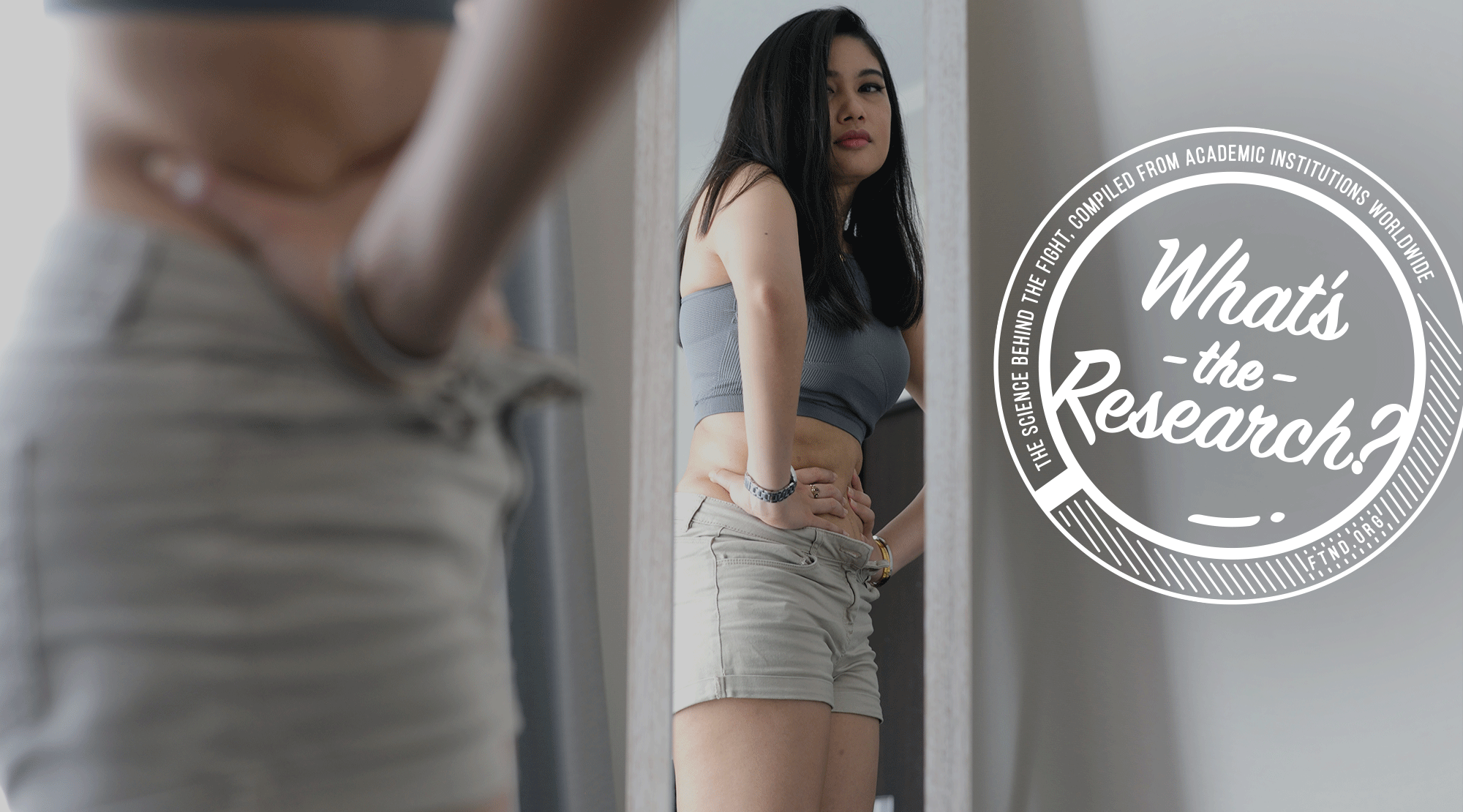Decades of studies from respected academic institutions, have demonstrated significant impacts of porn consumption for individuals, relationships, and society. "What’s the Research" aims to shed light on the expanding field of academic resources that showcase porn’s harms in a variety of ways. Below are selected excerpts from published studies on this issue.
The full study can be accessed here.
Perceptions of Male Partner Pressure to be Thin and Pornography Use: Associations with Eating Disorder Symptomatology in a Community Sample of Adult Women
Authors: Tracy L. Tylka and Rachel M. Calogero
Published: January 2019
Peer-Reviewed Journal: The Journal of Sex Research (2018) 55:3, 310-319
Background
If women perceive that their bodies are heavier than their male partners prefer, they may be more likely to engage in disordered eating to modify their bodies to better fit this perceived preference and/or manage negative affect from this body image-related threat (Schembri & Evans, 2008). In this study, the researchers explored two male partner variables that may be uniquely linked to women’s eating disorder symptoms: perceived thinness-related pressure and pornography use.
For adolescent girls and young adult women, perceived partners’ hurtful comments about weight and encouragement to diet are positively associated with eating disorders and body dissatisfaction (Carriere & Kluck, 2014). Two previous studies have examined this link with adult community women and they found that perceived thinness-related partner pressures were linked to thin-ideal internalization and restrained eating (Huxley, Halliwell, & Clarke, 2015; Tylka, Russell, & Neal, 2015).
Pornography use, which is common among adult heterosexual men (Poulsen, Busby, & Galovan, 2013), may also serve as a weight-related pressure. Women in pornography tend to be thin or curvaceously thin, weighing 48 lbs less than the average adult woman (Millward, 2013). A woman who knows or believes that her male partner is looking at women in pornography may view her body as “not thin enough,” especially if she perceives herself as heavier than women in pornography. Indeed, women’s body image is negatively impacted by male partner pornography use (Wright & Tokunaga, 2018). One published study has examined the relationship between perceived partner pornography use and eating disorder symptomatology and revealed that previous, but not current, use was linked to a global measure of disordered eating among college women, although not all participants were in a current relationship (Tylka & Kroon Van Diest, 2015).
Methods
Human subjects approval was granted from Ohio State University. Adult U.S. women in current relationships with men were recruited from Amazon Mechanical Turk, completed the measures in random order, and were remunerated $1.00. Women who identified as single or failed validity questions gauging attentiveness were excluded, leaving 409 women (mean age = 33.5, range = 18–64). Women identified as White (78.5%), African American (6.4%), Asian (7.1%), multiracial (4.1%), or Latina (3.9%) and were married (47.1%), or in a long‐term (≥1 year; 44.1%) or new (<1 year; 8.8%) relationship, with men. Median household income was in the $45,000–$60,000 range. Most had attended college (85.2%), and some obtained a degree (36.9%).
The participants completed the Eating Attitudes Test‐26 (Garner, Olmsted, Bohr, & Garfinkel, 1982) and the Perceived Sociocultural Pressures Scale (Stice, Ziemba, Margolis, & Flick, 1996), which measures the extent participants “felt pressure from their partner to lose weight” and “noticed a strong message from their partner to have a thin body.” Participants also estimated how many hours per week they perceived that their current partner views pornography and estimated how often previous partners have viewed pornography. Participants also indicated whether they would be bothered by their partner’s pornography use.
Results
The findings from this study uphold the connections between perceived partner thinness‐related pressure, perceived pornography use, and adult community women’s eating disorder symptoms. Perceived partner thinness‐related pressure was uniquely associated with all eating disorder symptoms investigated. Importantly, standardized coefficients revealed that partner pressure was stronger than friend pressure and often family pressure, and as strong as media pressure, in explaining women’s eating disorder symptoms. Although extensive research has been conducted on media pressure (Holland & Tiggemann, 2016), relatively little work has been conducted on partner pressure.
Perceived current partner pornography use was also uniquely associated with women’s overall dieting and specific symptoms of body fat preoccupation, extreme eating‐related guilt, and vomiting after eating. Perceived previous partner pornography use was uniquely connected to all eating disorder symptoms investigated. Perhaps negative associations between perceived partner pornography use and certain eating disorder symptoms (e.g., binge eating) are formed early in women’s relationship histories, rendering perceived pornography use in current relationships not as significant.
Importantly, perceived partner pressure and previous partner pornography use were linked to eating disorder symptomatology both directly and indirectly through thin‐ideal internalization. These partner variables may position women to internalize the thin (and the curvaceously thin) ideal as a personal standard, but this internalization was not the only path toward eating disorder symptoms. Thin‐ideal internalization was less relevant for current partner pornography use, as this perceived use was directly, not indirectly, associated with dieting. Collectively, findings suggest that women in relationships with men may engage in eating disorder symptoms for reasons other than a personal desire to be thin. One reason may be to try to conform to what they perceive as male partner’s female body‐type preference, and another may be to manage negative effect that could arise from this body‐related threat.

